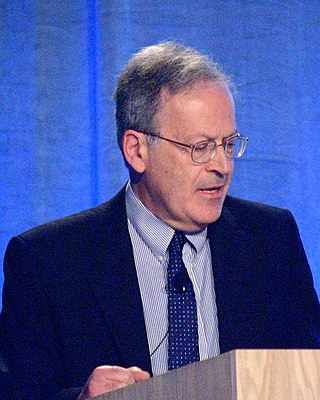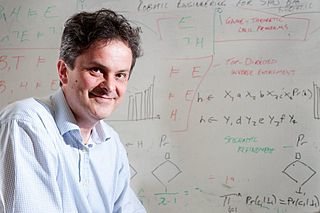Related Research Articles

Stephen Arthur Cook is an American-Canadian computer scientist and mathematician who has made significant contributions to the fields of complexity theory and proof complexity. He is a university professor emeritus at the University of Toronto, Department of Computer Science and Department of Mathematics.

John McCarthy was an American computer scientist and cognitive scientist. He was one of the founders of the discipline of artificial intelligence. He co-authored the document that coined the term "artificial intelligence" (AI), developed the programming language family Lisp, significantly influenced the design of the language ALGOL, popularized time-sharing, and invented garbage collection.

The School of Informatics is an academic unit of the University of Edinburgh, in Scotland, responsible for research, teaching, outreach and commercialisation in informatics. It was created in 1998 from the former department of artificial intelligence, the Centre for Cognitive Science and the department of computer science, along with the Artificial Intelligence Applications Institute (AIAI) and the Human Communication Research Centre.

Samson Abramsky is Professor of Computer Science at University College London. He was previously the Christopher Strachey Professor of Computing at Wolfson College, Oxford, from 2000 to 2021.

Logic in computer science covers the overlap between the field of logic and that of computer science. The topic can essentially be divided into three main areas:

Robert Anthony Kowalski is an American-British logician and computer scientist, whose research is concerned with developing both human-oriented models of computing and computational models of human thinking. He has spent most of his career in the United Kingdom.

Ernst Witt was a German mathematician, one of the leading algebraists of his time.

Leslie Gabriel Valiant is a British American computer scientist and computational theorist. He was born to a chemical engineer father and a translator mother. He is currently the T. Jefferson Coolidge Professor of Computer Science and Applied Mathematics at Harvard University. Valiant was awarded the Turing Award in 2010, having been described by the A.C.M. as a heroic figure in theoretical computer science and a role model for his courage and creativity in addressing some of the deepest unsolved problems in science; in particular for his "striking combination of depth and breadth".
Anil Nerode is an American mathematician, known for his work in mathematical logic and for his many-decades tenure as a professor at Cornell University.

The history of computer science began long before the modern discipline of computer science, usually appearing in forms like mathematics or physics. Developments in previous centuries alluded to the discipline that we now know as computer science. This progression, from mechanical inventions and mathematical theories towards modern computer concepts and machines, led to the development of a major academic field, massive technological advancement across the Western world, and the basis of a massive worldwide trade and culture.

A refactorable number or tau number is an integer n that is divisible by the count of its divisors, or to put it algebraically, n is such that . The first few refactorable numbers are listed in as

Alan Richard Bundy is a professor at the School of Informatics at the University of Edinburgh, known for his contributions to automated reasoning, especially to proof planning, the use of meta-level reasoning to guide proof search.

Stephen H. Muggleton FBCS, FIET, FAAAI, FECCAI, FSB, FREng is Professor of Machine Learning and Head of the Computational Bioinformatics Laboratory at Imperial College London.
Computational logic is the use of logic to perform or reason about computation. It bears a similar relationship to computer science and engineering as mathematical logic bears to mathematics and as philosophical logic bears to philosophy. It is an alternative term for "logic in computer science".

Computational creativity is a multidisciplinary endeavour that is located at the intersection of the fields of artificial intelligence, cognitive psychology, philosophy, and the arts.

Carl Eddie Hewitt was an American computer scientist who designed the Planner programming language for automated planning and the actor model of concurrent computation, which have been influential in the development of logic, functional and object-oriented programming. Planner was the first programming language based on procedural plans invoked using pattern-directed invocation from assertions and goals. The actor model influenced the development of the Scheme programming language, the π-calculus, and served as an inspiration for several other programming languages.
Mark d'Inverno is a British computer scientist, currently a professor of Computer Science at Goldsmiths, University of London, in east London, England.
Judith Anne (Judy) Goldsmith is a computer scientist whose publications span a wide range of topics including artificial intelligence, computational complexity theory, decision theory, and computer science education. She is a professor of computer science at the University of Kentucky.
Francesca Toni is an Italian computer scientist who works at Imperial College London in the UK as JP Morgan/Royal Academy of Engineering Research Chair in Argumentation for Interactive Explainable AI, Professor in Computational Logic in the Department of Computing, and head of the Computational Logic and Argumentation Group. Her research interests include explainable artificial intelligence, computational logic, argumentation theory, and applications in public health.
References
- 1 2 El Pais - "Las máquinas dan signos de saber apreciar la pintura" elpais.com 25.09.2010. Accessed 22 June 2011.
- ↑ The Painting Fool
- ↑ Simon Colton List of publications from the DBLP Bibliography Server. Accessed 22 June 2011.
- ↑ Emotionally aware automated portrait painting - Proceedings of the 3rd international conference on Digital Interactive Media in Entertainment and Arts
- ↑ Rise of the Robogeeks - New Scientist
- ↑ Cooper, C.N. and Kennedy, R. E. "Tau Numbers, Natural Density, and Hardy and Wright's Theorem 437." Internat. J. Math. Math. Sci. 13, 383-386, 1990
- ↑ S. Colton, "Refactorable Numbers - A Machine Invention," Journal of Integer Sequences, Vol. 2 (1999), Article 99.1.2